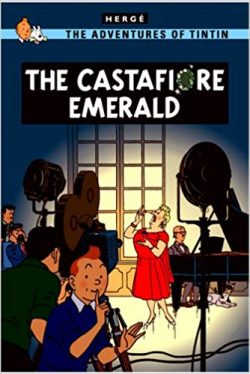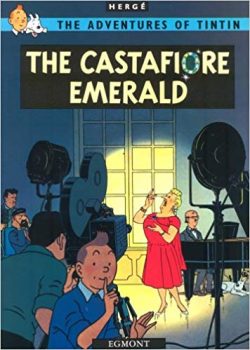

By Hergé, Bob De Moor, Roger Leloup and others, translated by Leslie Lonsdale-Cooper & Michael Turner (Egmont UK)
ISBN: 978-1-40520-820-8(HB) 978-1-40520-632-7(Album PB)
Win’s Christmas Gift Recommendation: A Great British Tradition of Belgian Origin. Get ‘Em All… 10/10
Georges Prosper Remi, known all over the world as Hergé, created a timeless masterpiece of graphic literature with his tales of a plucky boy reporter and entourage of iconic associates.
Singly, and later with assistants including Edgar P. Jacobs, Bob de Moor and other supreme stylists of the Hergé Studio, he created 23 timeless yarns (initially serialised in instalments for a variety of newspaper periodicals) which have grown beyond their pop culture roots to attain the status of High Art.
On leaving school in 1925, Remi began working for conservative Catholic newspaper Le Vingtiéme Siécle where he fell under the influence of its Svengali-esque editor Abbot Norbert Wallez. A devoted boy scout, one year later the artist was producing his first strip series – The Adventures of Totor – for monthly Boy Scouts of Belgium magazine. By 1928 Remi was in charge of producing the contents of the newspaper’s weekly children’s supplement Le Petit Vingtiéme.
While he was illustrating The Adventures of Flup, N̩nesse, Poussette and Cochonette written by the staff sports reporter РWallez required his compliant creative cash-cow to concoct a new and contemporary adventure series. Perhaps a young reporter who roamed the world, doing good whilst displaying solid Catholic values and virtues?
The rest is history…
Some of that history is quite dark: During the Nazi Occupation of Belgium, Le Vingtiéme Siécle was closed down and Hergé was compelled to move his supremely popular strip to daily newspaper Le Soir (Brussels’ most prominent French-language periodical, and thus appropriated and controlled by the Nazis).
He diligently toiled on for the duration, but following Belgium’s liberation was accused of collaboration and even of being a Nazi sympathiser. It took the intervention of Belgian Resistance war-hero Raymond Leblanc to dispel the cloud over Hergé, which he did by simply vouching for the cartoonist through words and deeds.
Leblanc provided cash to create a new magazine – Le Journal de Tintin – which he published and managed. The anthology comic swiftly achieved a weekly circulation in the hundreds of thousands, which allowed Remi and his growing studio team to remaster past tales: excising material dictated by the Fascist occupiers and reluctantly added to ideologically shade the wartime adventures. These modernising post-war exercises also generally improved and updated the great tales, just in time for Tintin to become a global phenomenon.
With the war over and his reputation restored, Hergé entered the most successful period of his artistic career. He had mastered his storytelling craft, possessed a dedicated audience eager for his every effort and was finally able to say exactly what he wanted in his work, free from fear or censure.
Sadly, Hergé’s personal life was less satisfactory, but although plagued by physical and mental health problems, the travails only seemed to enhance his storytelling abilities…
Le Bijoux de la Castafiore was serialised in Le Journal de Tintin from 4th July 1961 to September 4th 1962 with the inevitable book collection released in 1963. For the first time, The English edition was published in the same years as its European original…
The Castafiore Emerald is quite a departure from the eerie bleak thriller that preceded it (Tintin in Tibet) and the general run of globetrotting tales. The resolution of that icy escapade seemed to have purged much of the turmoil and trauma from the artist’s psyche.
His production rate – but not the quality – slowed to a leisurely crawl as he became a world traveller himself, visiting America, Taiwan and many other places he had featured in the exploits of his immortal boy reporter. Fans would wait fifteen years for these last three adventures to be done.
When the blithely unstoppable operatic grand dame Bianca Castafiore imposes herself on Captain Haddock at Marlinspike Hall – complete with fawning entourage and a swarm of reporters in hot pursuit – she turns the place upside down, destroying the irascible mariner’s peace-of-mind.
A flighty force of nature claiming to crave isolation and quiet recuperation, the Diva floods Marlinspike with anxiety, just as Tintin and the Captain are attempting to win fair treatment for a roving band of gipsies (let’s call them Roma now, shall we?).
Much to the chagrin of the irascible mariner, when the pride of Castafiore’s fabulous jewels is stolen, events take a constantly escalating, surreal and particularly embarrassing turn before Tintin finally solves the case through calm, cool deduction.
Unlike the rest of the canon, this tale is restricted – like a drawing room mystery – to one locale: the impressive house and grounds inherited by Haddock as inhabited by a hilarious cast of regulars including acerbic, long-suffering butler Nestor and deranged genius Professor Calculus. It reads very much like an Alfred Hitchcock sparkling thriller from the 1950s: Light, airy, even frothy in places, with the emphasis always on laughs…
There are no real villains but plenty of diabolical happenstance generating slapstick action and wry humour while affording Herg̩ plenty of opportunities to take pot-shots at the media, Society РHigh and low Рand even the then-pervasive and ever-growing phenomenon of television itself.
The tale was published in 1961. It would be five years until the next one.
At least you don’t have to wait: this comics masterpiece can – and should – be yours as soon as possible.
The Castafiore Emerald: artwork © 1963 by Casterman, Paris & Tournai. Text © 1963 Methuen & Co Ltd. All rights reserved.
